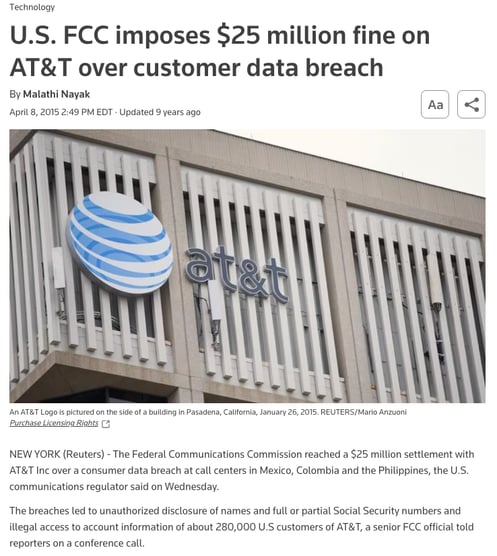In today's digital age, data breaches have become a significant concern for businesses of all sizes. Protecting sensitive corporate information is crucial to maintaining customer trust and safeguarding valuable assets. However, many organizations fall victim to data breaches due to common mistakes that can be prevented with the proper precautions.
The consequences of a corporate data breach can be severe and wide-ranging, impacting various aspects of a business, such as financial repercussions, damage to an organization's brand reputation, and loss of intellectual property, to name a few.
In addition to surface-level costs, data breaches incur hidden expenses such as legal fees, public relations efforts, investigations, insurance premium hikes, and regulatory fines. These costs can escalate quickly and significantly impact a company's financial health. Moreover, data breaches often have legal implications, with companies having to navigate notification requirements for affected individuals, potential penalties for non-compliance with regulations, and lastly, the possibility of lawsuits from affected parties. The regulatory burden post-breach can be substantial and add to business costs.
In 2015, the Federal Communications Commission (FCC) fined AT&T $25 million for a data breach that compromised the personal information of thousands of customers. This incident highlighted the importance of data security and the need for telecommunications companies to prioritize the protection of sensitive customer data. The hefty fine imposed by the FCC served as a stark reminder to companies about the potential consequences of failing to adequately safeguard customer information. It also underscored the regulatory scrutiny that telecommunications companies face in relation to data breaches and privacy violations. As a result, AT&T and other companies in the industry have since implemented stronger security measures and protocols to prevent similar breaches in the future. This case serves as a cautionary tale for businesses across all sectors about the importance of maintaining robust data protection practices to safeguard customer trust and comply with regulatory requirements.
personal information of thousands of customers. This incident highlighted the importance of data security and the need for telecommunications companies to prioritize the protection of sensitive customer data. The hefty fine imposed by the FCC served as a stark reminder to companies about the potential consequences of failing to adequately safeguard customer information. It also underscored the regulatory scrutiny that telecommunications companies face in relation to data breaches and privacy violations. As a result, AT&T and other companies in the industry have since implemented stronger security measures and protocols to prevent similar breaches in the future. This case serves as a cautionary tale for businesses across all sectors about the importance of maintaining robust data protection practices to safeguard customer trust and comply with regulatory requirements.
It is reported that 93% of successful data breaches occur in less than one minute. Yet 80% of businesses take weeks to realize a violation occurred. And most times, the breach was the result of a common and easily identifiable mistake or oversight from an employee. Let's explore some of the most prevalent errors that lead to corporate data breaches.
CASE STUDY
Using Navigator to Identify a Hacker
A video hosting service was made aware of potential security breaches to their platform. They suspected that a hacker was behind the attacks and set out to identify the perpetrator by using Navigator’s People Search tool.
7 common mistakes that lead to data breaches
Weak Passwords
Using weak or easily guessable passwords is a common mistake that can make it easier for hackers to gain unauthorized access to sensitive data. It's essential to use strong, unique passwords for each account and consider using two-factor authentication for an added layer of security.
Lack of Employee Training
Employees are often the first line of defense against data breaches, but without proper training, they may inadvertently put sensitive information at risk. Training employees on data security best practices can help reduce the likelihood of a breach.
Unsecured Devices
Allowing employees to access company data on unsecured devices, such as personal laptops or mobile phones, can increase the risk of a data breach. To protect data on all devices, it's important to implement security measures, such as encryption and remote wiping capabilities.
Failure to Update Software
Failing to keep software and systems up to date with the latest security patches can leave vulnerabilities that hackers can exploit. Regularly updating software can help protect against known security threats.
Lack of Encryption
Data encryption is an essential security measure that can help protect data at rest and in transit. Failing to encrypt sensitive data can make it easier for hackers to access and exploit that information.
Poor Data Handling Practices
Inadequate data handling practices, such as storing sensitive information in unsecured locations or failing to dispose of old data properly, can increase the risk of a data breach. Establishing precise data handling policies and procedures can help mitigate this risk.
Insufficient Access Controls
Giving employees access to more data than they need to perform their jobs can increase the risk of a data breach. Implementing strong access controls, such as least privilege principles and role-based access control, can help limit the exposure of sensitive data.
Future Trends
Future trends suggest an increase in privacy and security awareness among individuals and organizations, driven by evolving regulatory landscapes and heightened cybersecurity threats. However, this awareness may also lead to a rise in new types of data breaches and attacks, necessitating continuous adaptation and innovation in security measures.
The advancement of artificial intelligence offers both advantages and challenges in detecting and combating security threats. AI-powered solutions can enhance threat detection capabilities, automate response mechanisms, and bolster overall security posture. However, the evolving nature of cyber threats underscores the importance of ongoing refinement and adaptation of AI technologies to effectively counter emerging risks.
In conclusion, by understanding the implications of digital vulnerabilities and adopting a comprehensive security approach, businesses and individuals can better protect themselves and mitigate real-world security risks effectively.
